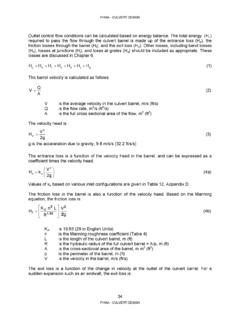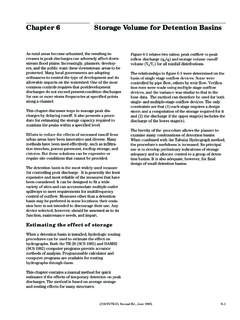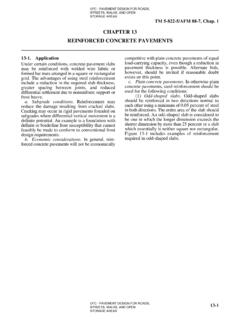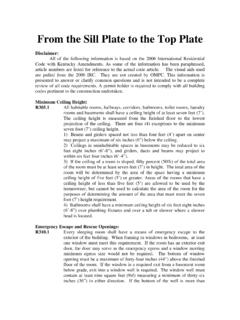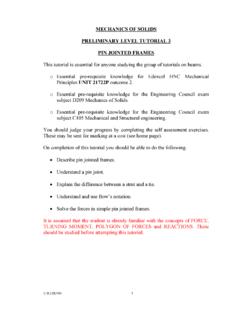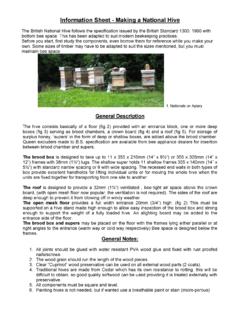Transcription of AASHTO Pavement Thickness Design Guide - …
1 AASHTO Pavement Thickness Design Guide When designing Pavement Thickness for flexible and rigid pavements, the following considerations should be used. 1. Performance criteria (serviceability indexes). Condition of pavements are rated with a present serviceability index (PSI) ranging from 5 (perfect condition) to 0 (impossible to travel). a. Initial serviceability index (Po) Po is considered to be that PSI immediately after the Pavement is open. AASHTO values are for rigid Pavement and for flexible Pavement . b. Terminal serviceability index (Pt) Pt is considered to be that PSI that represents the lowest acceptable level before resurfacing or reconstruction becomes necessary.
2 Pt = for Secondary Roads, Local Residential Streets. Pt = for Minor Collectors, Industrial and Commercial Streets. Pt = for Major Collectors and all Arterials. c. Serviceability loss (dPSI) dPSI is the difference between Po and Pt (Po Pt). The dPSI is the basis for the Pavement Design . 2. Design variables a. Analysis period (n) n is the period of time for which the analysis is to be conducted. Normally 50 years for concrete and 30 years for asphalt. b. Design Traffic (ESALs) ESALs is the estimate of number of Equivalent 18 kip Single Axle Loads (ESALs) during the analysis period is required.
3 This value can be estimated based on: The Average Annual Daily Traffic (AADT) in the base year The average percentage of trucks expected to use the road The average annual traffic growth rate, and The analysis period To estimate the Design ESALs, the following procedure may be used. 1.) Obtain an estimate of the Design AADT for the beginning, or base year of the analysis period. 2.) Obtain an estimate of the average percentage of the AADT that will be trucks. 3.) Calculate the ESALs for the base year. 4.) Calculate the growth factor based on the annual traffic growth rate (r %) and the analysis period (n).
4 Growth Factor = (((1+r)^n) 1)/r 5.) Multiply the base year ESALs by the Growth Factor to obtain the total ESALs for the analysis period. 1 c. Reliability (R %)/ Normal Deviation (ZR) R is the probability that the Design will succed for the life of the Pavement . The following reliability and normal deviation (ZR) values are recommended. Local Streets: R = 80%, ZR = Collector Streets: R = 88%, ZR = Arterial Streets: R = 95%, ZR = d. Overall standard deviation (So) So is the coefficient which describes how well the AASHTO Road Test data fits the AASHTO Design Equations.
5 The lower the overall deviation, the better the equations model the data. The following ranges are recommended. Rigid Pavements: to Flexible Pavements: to 3. Material properties for structural Design a. Roadbed soil resilient modulus (MR) MR is the property of the soil which indicates the stiffness or elasticity of the soil under dynamic loading. MR is also adjusted for seasonal fluctuation from temperature etc. b. Modulus of subgrade reaction (k and kc) k is the modulus of the subgrade soil. c. Approximate relationship of k to MR: k= d. Composite modulus of subgrade reaction (kc) kc is the composite modulus of the subbase materials, which will take into account any base placed on top of the subgrade.
6 If a base is used kc is input into the equation rather than k. Type of Soil Subgrade Strength K Value Range (pci) (Rigid Pavement ) Resilient Modulus MR, (psi) (Flexible Pavement CBRS ilts and clays of high compressibility ( liquid limit >= 50), natural density (not recommended for subgrades without treatment) Very Low50 1001000 27003 or less Fine grain soils in which silt and clay size particles predominate (low compressibility, liquid limit < 50) Low100 1502700 40003 to Poorly grades sands and soils that are predominately sandy with moderate amounts of silts and clays (well drained))
7 Medium150 2204000 to 12 Gravely soils, well graded sands, and sand gravel mixtures relatively free of plastic fines High220 250+ >5700>12 2 Approximate composite modulus of subgrade reaction (kc) for various Pavement conditions. Subgrade k Value Untreated Subbase Depth vs kc, pci, (LS=1) 4 in 6 in8 in10 in 50 27 313437 100 43 475156 150 57 626671 200 70 747885 Crushed stone use k = 100 and kc = 150 for 6 to 12 in of Thickness . Subgrade k Value Bituminous Subbase Depth vs kc, pci, (LS=0) 4 in 6 in8 in10 in 50 84 112141170 100 144 198243288 150 221 277334392 200 284 351419487 Subgrade k Value Cement Treated Subbase Depth vs kc, pci, (LS=0) 4 in 6 in8 in10 in 50 101 145193245 100 185 258334414 150 265 360460563 200 341 457577700 Subgrade k Value Lean Concrete Subbase Depth vs kc, pci, (LS=1) 4 in 6 in8 in10 in 50 104 156205262 100 192 271354443 150 274 378488603 200 353 480612750 e.
8 Concrete properties Modulus of Elasticity (Ec) and Modulus of Rupture (S c). S c is the 28 day Flexural Strength of the concrete. Ec can be derived from S c as follows Ec = 5700(S c). Flexural Strength (S c) can also be approximated from compressive strength (fc) as follows: S c = ^ (psi). f. Layer coefficients. Structural layer coefficients (ai) are required for flexible Pavement Design . A value for these coefficients is assigned to each layer material in the Pavement structure in order to convert actual layer Thickness into structural number (SN). Component CoefficientMinimum Thickness Surface/Intermediate Course Hot Mix Asphalt with Type A Aggregate 2 Hot Mix Asphalt with Type B Aggregate 2 Base Course 3 Type B Hot Mix Asphalt 2 Asphalt Treated Base Class I 4 Bituminous Treated Aggregate Base 6 Asphalt Treated Base Class II 4 Cold Laid Bituminous Concrete Base 6 Cement Treated Granular (Aggregate) 6 Soil Cement Base 6 Crushed (Graded) Stone Base 6 Macadam Stone Base 6 Portland Cement Concrete Base (New)
9 Old Portland Cement Concrete Crack and Seated PCC Rubblized PCC Cold in Place Recycled Subbase Course Soil Cement Subbase 6 Soil Lime Subbase 6 Granular Subbase 4 Soil Aggregate Subbase 4 4. Pavement structural characteristics a. Coefficient of drainage (Cd or Mi) Cd is the coefficient of drainage for rigid Pavement Design used to account for improved or decreased quality of drainage. Mi is the coefficient of drainage for flexible Pavement Design used to modify layer coefficients. Water under Pavement is one of the primary causes of Pavement failure. This will contribute to Pavement pumping under large numbers of heavy loads.
10 The following definitions are used as a Guide : Excellent drainage Material drained to 50% of saturation in 2 hours. Good drainage Material drained to 50% of saturation in 1 day. Fair drainage Material drained to 50% of saturation in 7 days. Poor drainage Material drained to 50% of saturation in 1 month. Very poor drainage Material does not drain. Based on these definitions the Cd or Mi value for Fair drainage would be A value of would have no impact on Pavement Thickness . Lower values increase the required Pavement Thickness ; higher values decrease the required Pavement Thickness .
